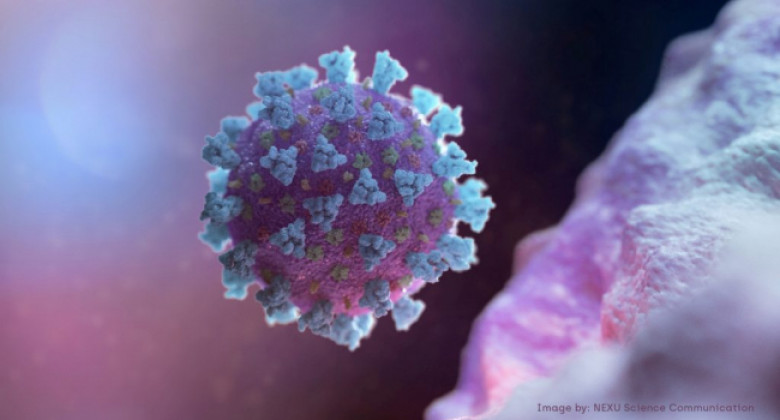Scientists identify marker of dangerous form of COVID-19 infection
ЛАЙФ
The Italian and Australian scientists have discovered a marker of a dangerous form of COVID-19 infection that can lead to the death of a patient.
According to a study published in the International Journal of Infectious Diseases, the level of serum amyloid protein in critically ill patients becomes abnormally high during an acute reaction of the body to the SARS-CoV-2 coronavirus.
Health Europe reported that scientists conducted a meta-analysis of studies from the PubMed, Web of Science, and Scopus databases, which examined the link between the severity of COVID-19 symptoms, serum amyloid A (SAA) protein concentrations in patients with coronavirus, and patient survival. A total of 19 studies were included in the meta-analysis, which involved a total of 5617 patients with COVID-19. At the same time, in 3723 people (49%) the disease was mild or moderate.
Analysis of the results showed that SAA concentrations were significantly high in those patients who did not survive or who had a very severe form of COVID-19. The standardized mean difference (SMD) between the mild and severe patient groups was 1.20 with a 95% confidence interval of 0.91-1.49, indicating a strong relationship between high SAA values and severe COVID-19. Scientists have also found a link between amyloid A levels and gender, which may explain why men are more vulnerable to the virus.
Tracking SAA, which serves as a sign of severe complications of the disease, could be useful in identifying risk groups and monitoring the condition of patients with coronavirus infection, scientists said.
SAA is significantly activated during the acute phase response - a general body response that develops in response to the release of cytokines during infection. The normal concentration of amyloid A is 20-50 milligrams per liter, but it can increase up to 1000 times during the first 24-48 hours of the acute phase response. This is due to increased protein production in the liver, which is triggered in response to stimuli such as interferon-gamma, interleukin-1β and -6, and tumor necrosis factor (TNF). In turn, SAA enhances inflammation by increasing the synthesis of these stimuli and activating other pro-inflammatory cytokines that can cause cytokine storms and other complications in COVID-19.

 Добыча полезных ископаемых — занятие не для глупых. «Паст».
Добыча полезных ископаемых — занятие не для глупых. «Паст». Team Holding объявляет о начале размещения облигаций. Андеррайтером выступает Freedom Broker Armenia
Team Holding объявляет о начале размещения облигаций. Андеррайтером выступает Freedom Broker Armenia Почему бывший министр обороны «заговорил сейчас»? «Паст».
Почему бывший министр обороны «заговорил сейчас»? «Паст». «Почему стрелы были направлены именно в адрес “того, кто разнимает драку”. «Паст»
«Почему стрелы были направлены именно в адрес “того, кто разнимает драку”. «Паст» «Это издевательство над государственностью». «Паст»
«Это издевательство над государственностью». «Паст» Юнибанк первым в Армении выпустил бессрочные облигации
Юнибанк первым в Армении выпустил бессрочные облигации
 Спорное положение закона – политическая дубинка. «Паст»
Спорное положение закона – политическая дубинка. «Паст» Пашинян против Церкви: вместо борьбы с кризисом — борьба с Католикосом: «Паст»
Пашинян против Церкви: вместо борьбы с кризисом — борьба с Католикосом: «Паст» Пашинян: Вопрос Нагорного Карабаха был решен в 1996 г, просто никто нам об этом не говорил
Пашинян: Вопрос Нагорного Карабаха был решен в 1996 г, просто никто нам об этом не говорил Bloomberg: ЕС поставляет в Нигерию запрещенные пестициды, вызывающие рак
Bloomberg: ЕС поставляет в Нигерию запрещенные пестициды, вызывающие рак Пашинян: В документах по Карабаху есть детали, которые способны вызывать международные проблемы
Пашинян: В документах по Карабаху есть детали, которые способны вызывать международные проблемы США приостановили прием иммиграционных заявлений из 19 стран после стрельбы у Белого дома
США приостановили прием иммиграционных заявлений из 19 стран после стрельбы у Белого дома Рютте: Австралия и Новая Зеландия подключились к закупкам оружия для Украины
Рютте: Австралия и Новая Зеландия подключились к закупкам оружия для Украины Проект «Россия с вами»: специальная партия гуманитарной помощи для переселенцев из Нагорного Карабаха доставлена в Эчмиадзин
Проект «Россия с вами»: специальная партия гуманитарной помощи для переселенцев из Нагорного Карабаха доставлена в Эчмиадзин
 Team Holding объявляет о начале размещения облигаций. Андеррайтером выступает Freedom Broker Armenia
Team Holding объявляет о начале размещения облигаций. Андеррайтером выступает Freedom Broker Armenia
 Минфин Армении: Расходы на нужды ряда министерств было решено увеличить
Минфин Армении: Расходы на нужды ряда министерств было решено увеличить Татоян: Пять уроков, которые следует извлечь из публикации документов, связанных с Арцахским конфликтом
Татоян: Пять уроков, которые следует извлечь из публикации документов, связанных с Арцахским конфликтом Безопасная авантюра без «парашюта». «Паст»
Безопасная авантюра без «парашюта». «Паст» Оформите зарплатную карту в Юнибанке — получите шанс выиграть 1 000 000 драмов
Оформите зарплатную карту в Юнибанке — получите шанс выиграть 1 000 000 драмов Euromoney признал Америабанк лучшим банком Армении в сфере недвижимости второй год подряд
Euromoney признал Америабанк лучшим банком Армении в сфере недвижимости второй год подряд
 Отныне не «спонтанно», а организованно. «Паст».
Отныне не «спонтанно», а организованно. «Паст». Откуда они взяли «голубиную» технологию? «Паст».
Откуда они взяли «голубиную» технологию? «Паст». Министр обороны РА принял участие в открытии выставки «EDEX 2025» в Египте
Министр обороны РА принял участие в открытии выставки «EDEX 2025» в Египте Аджапахян и Галстанян выступили с заявлением: Предлагаем прекратить полномочия непокорных предстоятелей
Аджапахян и Галстанян выступили с заявлением: Предлагаем прекратить полномочия непокорных предстоятелей Рейтинговое агентство S&P Global Ratings присвоило ЗАО «АйДи Банк» долгосрочный рейтинг «BB-» и краткосрочный рейтинг «B» со «стабильным» прогнозом
Рейтинговое агентство S&P Global Ratings присвоило ЗАО «АйДи Банк» долгосрочный рейтинг «BB-» и краткосрочный рейтинг «B» со «стабильным» прогнозом Цена серебра обновила рекорд - $57,86 за унцию
Цена серебра обновила рекорд - $57,86 за унцию В Ереване обрушилась часть здания бывшего фортепианного завода: есть пострадавший
В Ереване обрушилась часть здания бывшего фортепианного завода: есть пострадавший Заседание Антикоррупционного суда по делу о признанной антиконституционной статье продолжится 17 декабря
Заседание Антикоррупционного суда по делу о признанной антиконституционной статье продолжится 17 декабря Эдмон Марукян обратился к Католикосу всех армян: Прошу лишить сана Навасарда Кчояна
Эдмон Марукян обратился к Католикосу всех армян: Прошу лишить сана Навасарда Кчояна «Альтернативные проекты»: Очень часто сложные вопросы имеют простые решения
«Альтернативные проекты»: Очень часто сложные вопросы имеют простые решения Автодороги на территории Армении в основном открыты для проезда транспорта
Автодороги на территории Армении в основном открыты для проезда транспорта WSJ: на переговорах во Флориде обсуждается «обмен территориями» и выборы в Украине
WSJ: на переговорах во Флориде обсуждается «обмен территориями» и выборы в Украине SIPRI сообщил о рекордных доходах крупнейших производителей оружия в 2024 году
SIPRI сообщил о рекордных доходах крупнейших производителей оружия в 2024 году Волонтёры «Евразия-Армения» провели субботник в парке имени Комитаса
Волонтёры «Евразия-Армения» провели субботник в парке имени Комитаса  Вековая дружба армянского и русского народов: круглый стол с участием экспертов
Вековая дружба армянского и русского народов: круглый стол с участием экспертов
 Итальянский пианист Антонио ди Кристофано выступит с сольным концертом в Ереване и проведет мастер-классы для армянских пианистов
Итальянский пианист Антонио ди Кристофано выступит с сольным концертом в Ереване и проведет мастер-классы для армянских пианистов
 Почему Арман Татоян не участвовал в слушаниях по делу политзаключённых? «Паст»
Почему Арман Татоян не участвовал в слушаниях по делу политзаключённых? «Паст» Просто решили не возбуждать уголовное производство — и… всё. «Паст»
Просто решили не возбуждать уголовное производство — и… всё. «Паст» Где искать следы отмывания денег? «Паст»
Где искать следы отмывания денег? «Паст» Индийский миллиардер привезёт свои редкие Rolls-Royce на ралли классических автомобилей в ОАЭ
Индийский миллиардер привезёт свои редкие Rolls-Royce на ралли классических автомобилей в ОАЭ Фильм про адвоката Армена Мерджяна покажут на DOC NYC
Фильм про адвоката Армена Мерджяна покажут на DOC NYC В Русском доме в Ереване прошел круглый стол и презентация книги «Россия и Закавказье: история и культура»
В Русском доме в Ереване прошел круглый стол и презентация книги «Россия и Закавказье: история и культура»
 Песков: Россия ведёт переговоры по урегулированию на Украине только с США
Песков: Россия ведёт переговоры по урегулированию на Украине только с США Андрей Ермак подал в отставку с должности главы офиса президента Украины
Андрей Ермак подал в отставку с должности главы офиса президента Украины Активисты «Евразия-Армения» посетили Матенадаран: встреча с тысячелетним наследием
Активисты «Евразия-Армения» посетили Матенадаран: встреча с тысячелетним наследием Новый раздел в Idram&IDBank
Новый раздел в Idram&IDBank Несколько реальных и выгодных предложений в преддверии «Чёрной пятницы»: IDBank и Idram
Несколько реальных и выгодных предложений в преддверии «Чёрной пятницы»: IDBank и Idram Армянские спортсмены завоевали четыре медали на Сурдолимпийских играх 2025 в Токио
Армянские спортсмены завоевали четыре медали на Сурдолимпийских играх 2025 в Токио США намерены пересмотреть грин-карты, выданные лицам, иммигрировавшим из 19 стран
США намерены пересмотреть грин-карты, выданные лицам, иммигрировавшим из 19 стран Двое военнослужащих-контрактников пострадали в результате взрыва мины в Варденисе
Двое военнослужащих-контрактников пострадали в результате взрыва мины в Варденисе 





